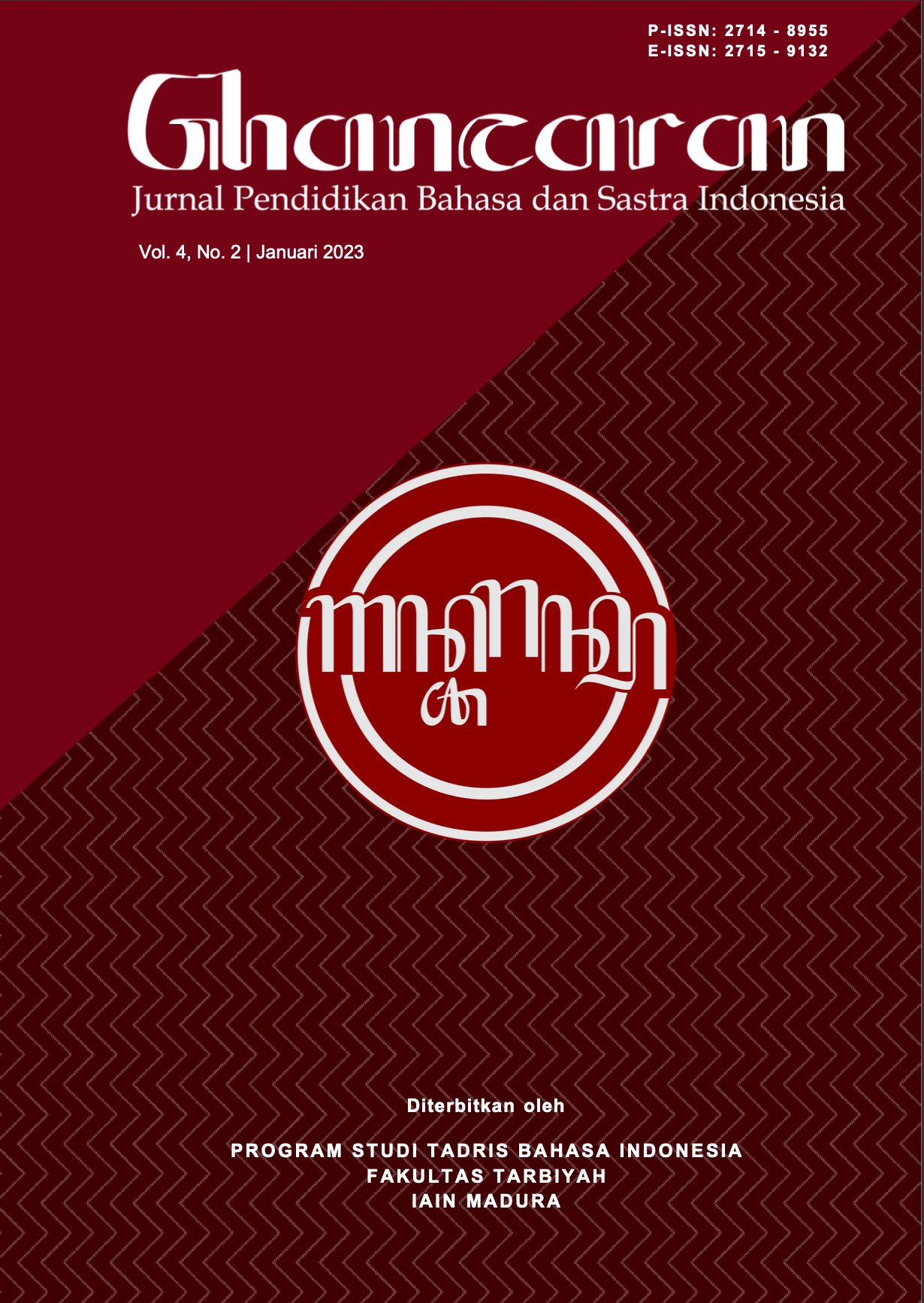Karakteristik Verba pada Laki-Laki dan Perempuan dalam Kolom Komentar YouTube Narasi Newsroom
 Abstract views: 467
,
Abstract views: 467
,
 PDF downloads: 428
PDF downloads: 428
Abstract
This research aims to describe the forms of verbs for men and women grammatically and social side; describe the semantic types of verbs for men and women grammatically and social side in the comments column of Narasi Newsroom’s Youtube. The research method used in this research is a descriptive method with a qualitative approach. The data in this study are the use of verbs used by men and women in the YouTube Narration Newsroom comments column. Data collection techniques consist of documentation techniques, comprehending and note-taking techniques. Data were analyzed using verb theory and language and gender theory. The result showed that there are 205 forms of verbs used by men, 238 forms of verbs used by women, 114 semantic types of verbs used by men, and 135 semantic types of verbs used by women. Characteristics of verb forms based on social side between men and women languages could be seen in the terms of diction and morphology in the form of affixation. Based on the aspect meaning, women use symbolic language while men use direct language at problem points. Women interact by increasing solidarity while men by maintaining power and status. The topic of conversation for women focuses on affective functions while men on competence.
Downloads
References
Alwi, H., & Sugono, D. (2012). Telaah Bahasa dan Sastra. Jakarta: Yayasan Obor Indonesia.
Arifin, E. Z., & Junaiyah. (2019). Morfologi: Bentuk, Makna, dan Fungsi. Jakarta: Grasindo.
Coates, J. (2004). Women, Men and Language. New York: Roultladge.
Finegan, E. (2012). Language: Its Structure and Use. United States: Cengage.
Georgiou, G. P. (2020). An Introduction to Issues in General Linguistics. United Kingdom: Cambridge Scholars Publishing.
Hermawan, I. (2019). Metodologi Penelitian Pendidikan Kuantitatif, Kualitatif, dan Mixed Methode. Kuningan: Hidayatul Quran Kuningan.
Hidayati, N. N. (2016). Bahasa dan Gender: Karakterisitik Kebahasaan Laki-Laki dan Perempuan dalam Film Anak. Al Hikmah Jurnal Studi Keislaman, 9-32.
Kemdikbud. (2017). Tata Bahasa Baku Bahasa Indonesia Edisi Keempat. Jakarta: Badan Pengembangan dan Pembinaan Bahasa.
Khak, M. A. (2015). Verba Kekuasaan SBY dalam Surat Kabar Berbahasa Indonesia (Powerful Verbs of SBY on Indonesian Newspaper. Kandai, 44-54.
Kisno. (2012). Fundamentals in Linguistics an Introduction. Jakarta: Halaman Moeka .
Kuntjara, E. (2013). Gender, Bahasa, dan Kekuasaan. Jakarta: PT. BPK Gunung Mulia.
Lakoff, R. (2004). Language and Woman’s Place: Text and Comentaris. New York: Oxford University Press.
Lakoff, R. (2015). Language and Women's Place. United Kingdom: Cambridge University Press.
Lyons, J. (2012). Language and Linguistics. United Kingdom: Cambridge University Press.
Mulyadi. (2019). Kategorisasi dan Peran Semantis Verba dalam Bahasa Indonesia. Jurnal Ilmiah Bahasa dan Sastra, 56-65.
Mulac, A., Studley, L. B., & Blau, S. (1990). The gender-linked effect in primary and secondary students’ impromptu essays. Sex Roles, 23, 439–4.
Nurfitri, R. (2015). Verba Predikat Bahasa Remaja dalam Majalah Remaja. Arkhais, 35-40.
Nusarini. (2016). Penggunaan Verba pada Surat Kabar Kompas . Caraka, 1-18.
Rukajat, A. (2018). Pendekatan Penelitian Kualitatif. Sleman: CV. Budi Utama.
Saleh, H. (2017). Bahasa dan Gender dalam Keragaman Pemahaman. Cirebon: Eduvision.
Scollon, R., & Scollon, S. W. (2012). Intercultural Communication. USA: Wiley Blackwell.
Thomson, R., & Murachver, T. (2001). Predicting gender from electronic discourse. British Journal of Social Psychology, 40, 193–208.
Wardhaugh, R. (2015). An Introduction to Sociolinguistics. USA: Wiley Blackwell.
Wodak, R. (2015). Gender and Language: Cultural Concerns. Contemporary Sociology, 698-703.
Copyright (c) 2023 GHANCARAN: Jurnal Pendidikan Bahasa dan Sastra Indonesia

This work is licensed under a Creative Commons Attribution-ShareAlike 4.0 International License.
Ghancaran: Jurnal Pendidikan Bahasa dan Sastra Indonesia uses an Open Access Policy under the Creative Commons Attribution-ShareAlike 4.0 International License. Authors publishing in this journal agree to the following terms:
- Ghancaran Journal holds the copyright and grants the journal rights for first publication with the work simultaneously licensed under a

The work is distributed under Creative Commons Attribution-ShareAlike 4.0 International License which allows others to share, copy, and redistribute the material in any media or format and adapt, remix, change, and develop the material even for commercial purposes, as long as it is stated credit and license derivative works under similar terms. - Authors may make additional contractual arrangements for non-exclusive distribution of the journal's published work version.
- Authors are permitted to post their work online (e.g., in institutional repositories or on their websites) before and during submission, as doing so may lead to productive exchange.



















